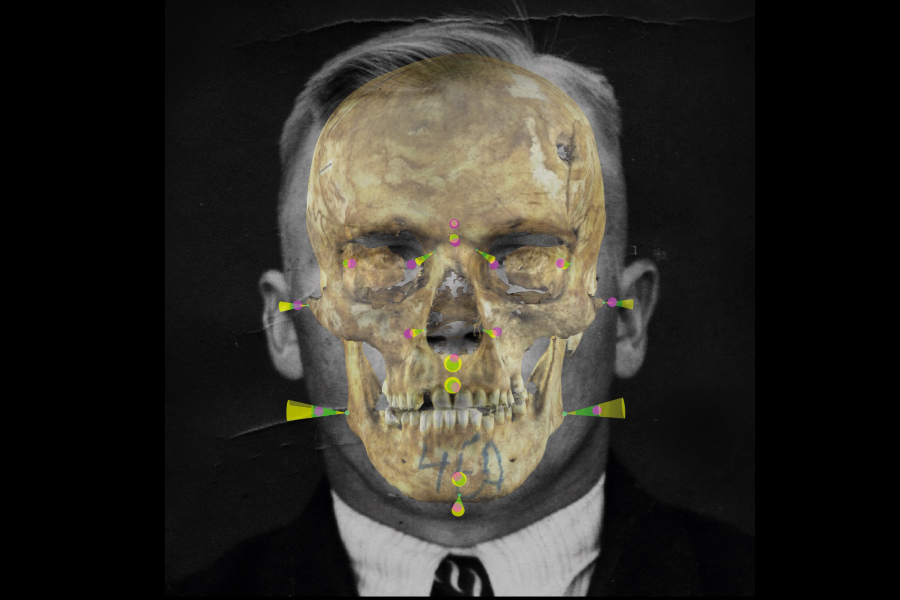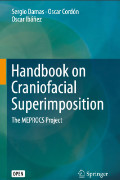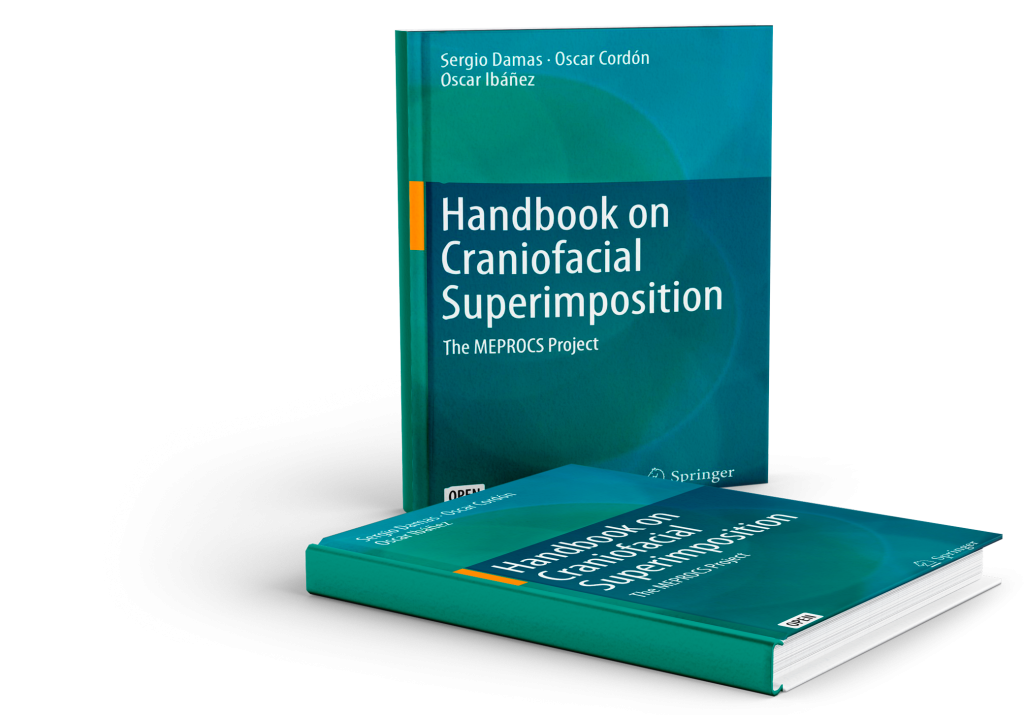Introductions
A quick introduction to Craniofacial Superimposition
Craniofacial Superimposition
Published on April 12, 2022
Written by Óscar Ibáñez

Craniofacial Superimposition (CFS) is probably the most challenging SFI method (Iscan and Helmer, 1993; Stephan, 2009). It involves the superimposition of an image of a skull with a number of ante-mortem (AM) face images of an individual and the analysis of their morphological correspondence. This skull-face overlay (SFO) process is usually done by corresponding anatomical (anthropometrical) landmarks located in the skull (craniometric) and the face (cephalometric). Thus, two objects of different nature are compared (a face and a skull).
CFS has the greatest applicability potential among skeleton-based identification methods as it only requires one or more facial photographs as AM data. However, is still considered a controversial technique within the scientific community with a lack of consensus regarding its reliability. On one hand, some authors classify it as a “useful” and “powerful” technique for positive identification. However, others believe that CFS is more suitable for the exclusion of individuals or as a source of corroborative evidence. It is the author’s opinion that it is not possible to make firm statements about the overall reliability of CFS methods due to the small number of published studies, the small samples used, and the significant number of limitations of these studies. At the same time, this technique is widely employed in many countries because its application is inexpensive and the only AM data required is one or more photographs of the face.
The most recent comprehensive surveys of the CFS field differentiate three consecutive stages (see Figure 3-3) for the whole CFS process (Damas et al., 2015; Huete et al., 2015): (1) the acquisition and processing of the materials, i.e., skull (or skull 3D model) and the AM facial photographs with the corresponding location of landmarks on both; (2) the SFO process, which deals with accomplishing the best possible superimposition of the skull on a single AM photograph of a missing person. This process is repeated for each available photograph, obtaining different overlays; (3) the decision making which evaluates the degree of support of being the same person or not (exclusion) based on the previous SFOs. This decision is influenced by the morphological correlation between the skull and the face, the matching between the corresponding landmarks according to the soft tissue depth, and the consistency between asymmetries. These criteria can vary depending on the region and the pose (Damas et al., 2015).
In 2020, the MEPROCS consortium, formed by leading CFS researchers and practitioners worldwide, published the Handbook on Craniofacial Superimposition, which is the first comprehensive guide on this important identification method. The e-book can be downloaded free of charge. At Panacea, we have prepared a quick start guide for the daily use of CFS that can also be downloaded free of charge.
Below, you find a list of important publications in the field of Craniofacial Superimposition. If you have any questions about the topic, please don’t hesitate to contact us.
Written by:
Dr. Óscar Ibáñez
Dr. Oscar Ibáñez is co-founder and CEO of Panacea Cooperative Research and an affiliated researcher at the DASCI Research Institute. He has developed his studies at five different universities and his research career in four laboratories. In addition, he has carried out stays in five other laboratories and short visits to approximately 20 institutions as part of different national and international projects.

He has received prizes from renowned international scientific societies: IFSA, EUSFLAT, ISFRI, IEEE CIS, CAEPIA. He co-authored five patents, and more than 100 scientific articles, and participated in more than 30 EU, national and regional R&D projects, leading 10 of them. His work focuses on the research and transfer of Artificial Intelligence techniques with the aim of creating solutions with social impact, with a special interest in the field of human rights (forensic identification).
Publications
- S. Damas, O. Cordón, O. Ibáñez. Handbook on Craniofacial Superimposition. ISBN 978-3-319-11136-0 ISBN 978-3-319-11137-7 (eBook), Springer. 2020
- J.S. Tan, I.Y. Liao, I. Venkat, et al. Computer-aided superimposition via reconstructing and matching 3D faces to 3D skulls for forensic craniofacial identifications. The Visual Computer 2020; 36:1739–1753.
- L. Faria-Porto, L. N. Correia-Lima, M. Flores, A. Valsecchi, O. Ibáñez, C. E. Machado-Palhares, F. de Barros-Vidal. Automatic cephalometric landmarks detection on frontal faces: An approach based on supervised learning techniques. Digital Investigation 30 (2019) 108-116.
- A. Valsecchi, S. Damas, O. Cordón. A Robust and Efficient Method for Skull-Face Overlay in Computerized Craniofacial Superimposition. IEEE Transactions on Information Forensics and Security 13:8 (2018), 1960-1974.
- C. Campomanes-Álvarez, R. Martos-Fernández, C. Wilkinson, O. Ibáñez, and O. Cordón. Modeling skull-face anatomical/morphological correspondence for craniofacial superimposition-based identification. IEEE Transactions on Information Forensics and Security 13:6 (2018) 1481 – 1494.
- M. Singh, S. Nagpal, R. Singh, et al. Learning A Shared Transform Model for Skull to Digital Face Image Matching. In: 2018 IEEE 9th International Conference on Biometrics Theory, Applications and Systems (BTAS).
- C. Campomanes-Álvarez, O. Ibáñez, O. Cordón, C. Wilkinson. Hierarchical Decision Support Framework for Craniofacial Superimposition. Information Fusion 39 (2018), 25-40.
- E. Bermejo, S. Damas, C. Campomanes-Alvarez, A. Valsecchi, O. Ibañez. Genetic algorithms for skull-face overlay including mandible articulation. Information Sciences 420 (2017) 200-217.
- S. Nagpal, M. Singh, A. Jain, et al. On matching skulls to digital face images: A preliminary approach. In: 2017 IEEE International Joint Conference on Biometrics (IJCB). 2017, pp. 813-819.
- O. Ibáñez, R. Vicente, D. Navega, B. R. Campomanes-Álvarez, C. Cattaneo, R. Jankauskas, M. I. Huete, F. Navarro, R. Hardiman, E. Ruiz, K. Imaizumi, F. Cavalli, E. Veselovskaya, D. Humpire, J. Cardoso, F. Collini, D. Mazzarelli, D. Gibelli, S. Damas. MEPROCS framework for Craniofacial Superimposition: validation study. Legal Medicine 23 (2016) 99-108.
- O. Ibáñez, R. Vicente, D.S. Navega, C. Wilkinson, P.T. Jayaprakash, M.I. Huete, T. Briers, R. Hardiman, F. Navarro, E. Ruiz, F. Cavalli, K. Imaizumi, R. Jankauskas, E. Veselovskaya, A. Abramov, P. Lestón, F. Molinero, J. Cardoso, A.S. Çağdir, D. Humpire, Y. Nakanishi, A. Zeuner, A.H. Ross, D. Gaudio, S. Damas. Study on the performance of different craniofacial superimposition approaches (I). Forensic Science International, 257 (2015) 496-503.
- S. Damas, C. Wilkinson, T. Kahana, E. Veselovskaya, A. Abramov, R. Jankauskas, P.T. Jayaprakash, E. Ruiz, F. Navarro, M.I. Huete, E. Cunha, F. Cavalli, J. Clement, P. Leston, F. Molinero, T. Briers, F. Viegas, K. Imaizumi, D. Humpire, O. Ibáñez. Study on the performance of different craniofacial superimposition approaches (ii): best practices proposal. Forensic Science International, 257 (2015) 504-8.
- M.I. Huete, T. Kahana, O. Ibáñez, C. Wilkinson. Past, present, and future of Craniofacial Superimposition: literature and international surveys. Legal Medicine 17:4 (2015) 267-278.
- B.R. Campomanes -Álvarez, O. Ibáñez, C. Campomanes-Álvarez, S. Damas, O. Cordón. Modeling facial soft tissue thickness for automatic skull-face overlay. IEEE Trans Inf Forensics Security 10:10 (2015) 2057-2070..
- O. Ibáñez, F. Cavalli, B. R. Campomanes-Alvarez, C. Campomanes-Álvarez, A. Valsecchi, M. I. Huete. Ground truth data generation for skull-face overlay. International Journal of Legal Medicine 129:3 (2015) 569–581.
- B. R. Campomanes-Álvarez, O. Ibáñez, F. Navarro, I. Alemán, O. Cordón, S. Damas. Dispersion assessment in the location of facial landmarks on photographs. International Journal of Legal Medicine 129:1 (2015) 227–236.
- B. R. Campomanes-Álvarez, O. Ibáñez, F. Navarro, I. Alemán, M. Botella, S. Damas, O. Cordón. Computer Vision and Soft Computing for Automatic Skull-Face Overlay in Craniofacial Superimposition. Forensic Science International 245 (2014) 77-86.
- F. Duan, Y. Yang, Y. Li, et al. Skull Identification via Correlation Measure Between Skull and Face Shape. IEEE Transactions on Information Forensics and Security 2014; 9: 1322-1332.
- S. Damas, O. Cordón, O. Ibáñez, J. Santamaría, I. Alemán, MC. Botella, F. Navarro. Forensic Identification by Computer-aided Craniofacial Superimposition: A Survey. ACM Computing Surveys 43:4 (2011) 27:1-27:27..
- O. Ibáñez, O. Cordón, S. Damas, J. Santamaría. Modeling the skull-face overlay uncertainty using fuzzy sets. IEEE Transactions on Fuzzy Systems 19:5 (2011) 946-959.
- C.N. Stephan. Craniofacial identification: techniques of facial approximation and craniofacial superimposition. In: Blau S, Ubelaker DH, editors. Handbook of forensic anthropology and archaeology. California: Left Coast Press; 2009.p. 304–21.
- O. Ibáñez, L. Ballerini, O. Cordón, S. Damas, J. Santamaría. An Experimental Study on the Applicability of Evolutionary Algorithms to Craniofacial Superimposition in Forensic Identification. Information Sciences 179:23 (2009) 3998-4028.
- T.W. Fenton, A.N. Heard, N.J. Sauer. Skull-photo superimposition and border deaths: identification through exclusion and the failure to exclude. J Forensic Sci 2008;53:34–40.
- C.N. Stephan, E.K. Simpson. Facial soft tissue depths in craniofacial identification (Part I): an analytical review of the published adult data. J Forensic Sci 2008;53:1257–72.
- M. Yoshino. Craniofacial superimposition. In: Wilkinson CM, Rynn C, editors. Craniofacial identification. Cambridge: University Press; 2012. p. 238–53.
- G.M. Gordon, M. Steyn. An investigation into the accuracy and reliability of skull-photo superimposition in a South African sample. Forensic Sci Int 2012;216:198. e1–198. e6.
- M. Ishii, K. Yayama, H. Motani, et al. Application of superimposition based personal identification using skull computed tomography images. J Forensic Sci 2011;56:960–6.
- A. Ricci, G.L. Marella, M.A. Apostol. A new experimental approach to computeraided face/skull identification in forensic anthropology. Am J Forensic Med Pathol 2006;27:46–9.
- A. Ghosh, P. Sinha. An economised craniofacial identification system. Forensic Sci Int 2001;117:109–19.
- Jayaprakash P, Srinivasan G, Amravaneswaran M. Cranio-facial morphanalysis: a new method for enhancing reliability while identifying skulls by photo superimposition. Forensic Sci Int 2001;117:121–43.
- H. Solla, M.Y. Iscan. Skeletal remains of Dr. Eugenio Antonio Berrios Sagredo. Forensic Sci Int 2001;116:201–11.
- D.H. Ubelaker. A history of Smithsonian-FBI collaboration in forensic anthropology, especially in regard to facial imagery. Forensic Sci Commun 2000:2.
- W. Aulsebrook, M.Y. Iscan, J. Slabbert, et al. Superimposition and reconstruction in forensic facial identification: a survey. Forensic Sci Int 1995;75:101–20.
- M. Yoshino, K. Imaizumi, S. Miyasaka, et al. Evaluation of anatomical consistency in craniofacial superimposition images. Forensic Sci Int 1995;74:125–34.
- Y. Lan. A study on national differences in identification standards for Chinese skull-image superimposition. Forensic Sci Int 1995;74:135–53.
- D. Austin-Smith, W.R. Maples WR. The reliability of skull/photograph superimposition in individual identification. J Forensic Sci 1994;39:446–55.
- P.C. Sekharan. A scientific method for positioning of the skull for photography in superimposition studies. Journal of Police Science and Administration 1993; 1(2): 232-240.
- M.Y. Iscan, R.P. Helmer. Forensic analysis of the skull. Wiley-Liss, 1993.
- D.H. Ubelaker, E. Bubniak, et al. Computer-assisted photographic superimposition. Journal of Forensic Sciences 1992; 37(3): 750-762.
- B.A. Nickerson, P.A. Fitzhorn, S.K. Koch, et al. A methodology for near-optimal computational superimposition of two-dimensional digital facial photographs and three-dimensional cranial surface meshes. J Forensic Sci 1991;36:480–500.
- D.S. Chai, Y.W. Lan, C. Tao, et al. A study on the standard for forensic anthropologic identification of skull-image superimposition. J Forensic Sci 1989;34:1343–56.
- J.J.I. McKenna. A method of orientation of the skull and camera for use in forensic photographic investigation. Journal of Forensic Sciences 1988; 33(3): 751-755.
- N. Sen. Identification by superimposed photographs. Int Crim Police Rev 1962;162:284–6.
- J. Glaister, J.C. Brash. Medico-legal aspects of the Ruxton case. Edinburgh: Livingstone; 1937.


